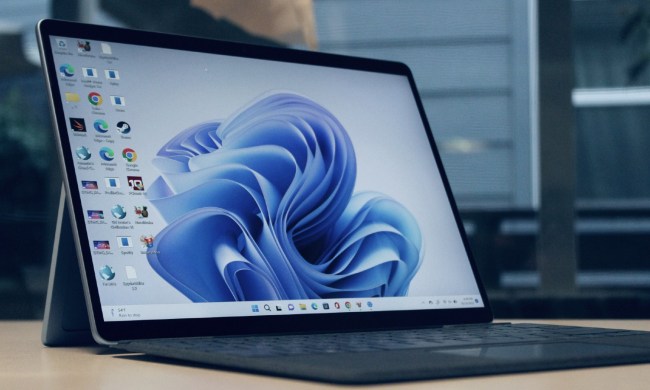Microsoft’s Surface Pro 8 shows up on both our best 2-in-1s and best laptops lists. It’s the best detachable tablet you can buy, with an advanced display and the most realistic digital inking around. But the 360-degree convertible 2-in-1 is another flexible form factor that can function better as a clamshell laptop while still providing tablet-like functionality.
One of the best convertible 2-in-1s is the Lenovo Yoga 9i 14 Gen 7, one of the first laptops released with Intel’s 12th-generation CPU. It’s a solid competitor to the Surface Pro 8, albeit with a very different design — does it have what it takes to take the place of Microsoft’s 2-in-1 at the top of the heap?
Specs
| Lenovo Yoga 9i 14 Gen 7 | Microsoft Surface Pro 8 | |
| Dimensions | 12.52 inches by 9.06 inches by 0.6 inches | 11.3 inches x 8.2 inches x 0.37 inches |
| Weight | 3.09 pounds | 1.96 pounds (tablet only) |
| Processor | Intel Core i5-1240P Intel Core i7-1260P Intel Core i7-1280P |
Core i5-1135G7 Core i7-1185G7 |
| Graphics | Intel Iris Xe | Intel Iris Xe |
| RAM | 8GB DDR5 16GB DDR5 |
8GB 16GB 32GB |
| Display | 14-inch 16:10 IPS Full HD+ (1920 x 1200) 14-inch 16:10 OLED WQHD+ (2880 x 1800) 14-inch 16:10 OLED WQUXGA (3840 x 2400) |
13-inch 3:2 IPS 2,880 x 1920 |
| Storage | 256GB PCI 4.0 solid-state drive 512GB PCIe 4.0 SSD 1TB PCIe 4.0 SSD |
128GB PCIe SSD 256GB PCIe SSD 512GB PCIe SSD 1TB PCIe SSD |
| Touch | Yes | Yes |
| Ports | 1 x USB-C 3.2 Gen 2 2 x USB-C 4.0 with Thunderbolt 4 1 x USB-A 3.2 Gen 2 3.5mm audio jack |
2 x USB-C with Thunderbolt 4 1 x Surface Connect 3.5mm audio jack Surface Type Cover MicroSD card reader |
| Wireless | Wi-Fi 6E and Bluetooth 5.2 | Wi-Fi 6 and Bluetooth 5.1 |
| Webcam | 1080p | Full HD |
| Operating system | Windows 11 | Windows 11 |
| Battery | 75 watt-hour | 51.5 watt-hour |
| Price | $1,450+ | $1,100+ |
| Rating | 4 out of 5 stars | 4 out of 5 stars |
Design
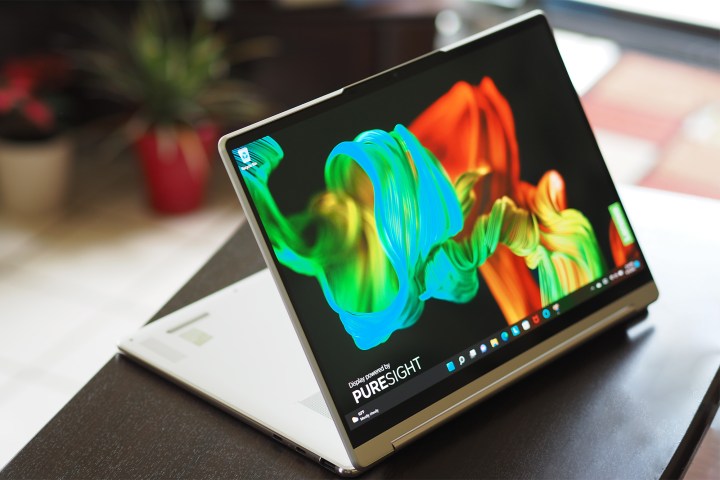
Both machines received significant revisions in their latest versions. The Yoga 9i 14 Gen 7 saw its sharp edges completely rounded out and layered in chrome, especially along the edges of the chassis. The lid’s edges retain an angle, giving the laptop a distinctive look from the sides. Those round chrome edges not only give the Yoga 9i 14 Gen 7 an elegant sleekness, but they also make it much more comfortable to hold in tablet mode.
You have a choice in colors, either Oatmeal (silver) or Storm Gray (dark gray), which carry throughout the laptop’s design. The Surface Pro 8’s display increased from 12.3 inches to 13 inches, and its bezels were thinned out, making the new version only slightly larger than its predecessor despite the larger screen. It retains the same slate design as before, coming in either Platinum (silver) or Graphite (black), with the iconic Surface Pro kickstand that extends out from the center of the back of the tablet. Both laptops are attractive, modern machines among the best-looking in their class.
The most significant difference between the two laptops is their 2-in-1 design. The Surface Pro 8 is a tablet first, with a Signature Type Cover keyboard that snaps magnetically to the bottom of the slate and turns it into a pseudo-clamshell machine. It’s not as stable in a lap as a typical laptop, but it works well when sitting on a flat surface. The Yoga 9i 14 Gen 7 is a 360-degree convertible with a display that swivels all the way around and allows the laptop to be used in four modes — clamshell, tent, media, and tablet. It’s more stable as a clamshell than the Surface Pro 8, but it’s not nearly as comfortable to use as a tablet. Which of these styles is better for you depends entirely on whether you need a tablet that can stand in for a clamshell or a clamshell that can function as a tablet on occasion.
The Yoga 9i 14 Gen 7 and Surface Pro 8 are both constructed of CNC machined aluminum. That’s a switch for the Surface Pro 8, which was previously made of lighter magnesium. Both laptops are built incredibly well, with no bending, flexing, or twisting. The Surface Pro 8’s kickstand holds the tablet firmly in place from almost straight up to lying almost completely flat, while the Yoga’s hinge allows opening the laptop with one hand while confidently keeping the lid in its chosen orientation. Choose either of these machines and you’ll gain some of the best build quality available in a laptop.
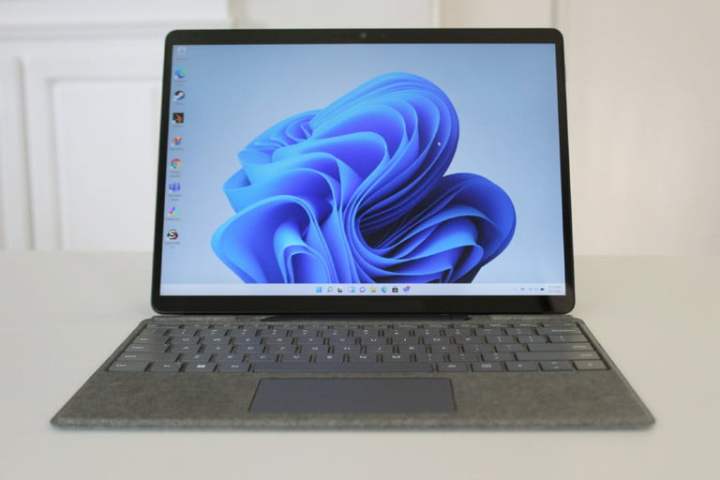
The Surface Pro 8’s optional Signature Type Cover provides a surprisingly good experience for a detachable keyboard. It offers large keycaps and wide key spacing with deep and snappy switches. It’s a precise keyboard, with the only complaint being that it bounces around a bit when it’s propped up at an angle. The Yoga 9i 14 Gen 7’s keyboard is also full-size, with a helpful row of special function keys along the right side that let you change the performance tuning, turn on background blur in video, switch audio and video modes, and log in via fingerprint reader. The Yoga’s switches aren’t as deep, however, and they’re softer, making it a much lighter keyboard that might not offer the precision some fast-touch typists are looking for. We rate the Surface Pro 8’s keyboard as better if you can handle the bounce.
The Yoga 9i 14 Gen 7’s touchpad is quite a bit larger than the one provided on the Signature Type Cover. Both are precise, though, thanks to Windows Precision drivers, and both provide reliable support for Windows 11’s multitouch gestures. There’s no doubt, though, that the Yoga’s larger version is more functional.
The Surface Pro 8 excels in this arena as a tablet made for pen use. The optional Surface Slim 2 Pen mates perfectly with the display and includes haptic feedback that more closely mimics the feel of a pencil on paper. The Yoga 9i 14 Gen 7’s included active pen is fine, but it can’t match the Surface Pro 8 for precise and natural inking. The Surface Slim 2 Pen also snaps into a slot on the Signature Type Cover for storage and charging, while the Yoga’s pen has no such convenience.
Connectivity is one area where the Yoga 9i 14 Gen 7 outclasses the Surface Pro 8. It includes a USB-C 3.2 Gen 2 port, a USB-A 3.2 Gen 2 port, two USB-C 4.0 ports with Thunderbolt 4 support, and a 3.5mm audio jack. The Surface Pro 8 has two USB-C 3.2 ports with Thunderbolt 4 support, the proprietary Surface Connect port, and a 3.5mm audio jack. The Surface Pro 8 also includes a microSD card reader, which the Yoga lacks. The Lenovo is also more up to speed in wireless support, with Wi-Fi 6E and Bluetooth 5.2 compared to the Surface Pro 8’s Wi-Fi 6 and Bluetooth 5.1.
The Surface Pro 8 supports Windows 11 Hello exclusively via an infrared camera and facial recognition, while the Yoga 9i 14 Gen 7 supports both facial recognition and fingerprint scanning. Lenovo also bundles in some privacy and security utilities, such as its Smart Assist utility that can turn off the display and put the laptop to sleep when you walk away, waking it up automatically when you return.
Performance
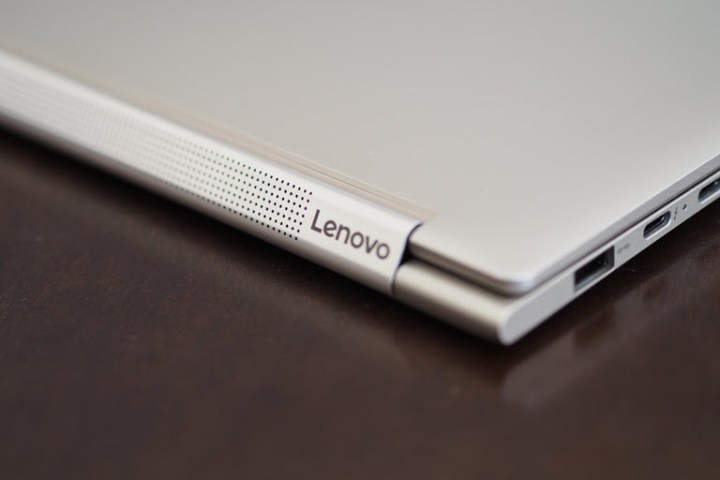
The Yoga 9i 14 Gen 7 equips Intel’s latest 12th-gen CPUs, hybrid designs with Performance and Efficient cores aimed at balancing speed and battery life. We reviewed the Yoga with the Core i7-1260P, a 28-watt CPU (64-watt Turbo Power) with 12 cores (four Performance and eight Efficient) and 16 threads. The chip is the faster version aimed at thin-and-light laptops, and it produced significantly increased performance over Intel’s 11th-gen CPUs that the Surface Pro 8 is built around. We reviewed the tablet with a Core i7-1185G7, a four-core/eight-thread processor running that can also run at 28 watts at maximum speed.
As the benchmark results in the table below demonstrate, the Yoga 9i 14 Gen 7 is significantly faster than the Surface Pro 8. Not only that, but the Yoga includes a performance tuning utility that can switch between quiet, balanced, and performance modes. These results reflect balanced mode, and performance mode provided a meaningful increase in each benchmark. For example, in our Handbrake test that encodes a 420MB video as H.265, the Yoga 9i 14 Gen 7 completed the test in just 101 seconds in performance mode compared to 130 seconds in balanced mode. Regardless, except for the 3DMark Time Spy test, the Surface Pro 8 fell far behind — and in performance mode, the Yoga scored a higher 1,979.
This is the one area where the Yoga simply outclasses the Surface. There’s no doubt that it will churn through demanding productivity workflows that might cause the Surface Pro 8 to struggle.
| Lenovo Yoga 9i 14 Gen 7 (Core i7-1260P) |
Microsoft Surface Pro 8 (Core i7-1185G7) | |
| Geekbench 5 (single / multi) |
1,717 / 9,231 | 1,296 / 5,041 |
| Handbrake (seconds) |
130 | 185 |
| Cinebench R23 (single / multi) |
1,626 / 7,210 | 1,287 / 5,431 |
| PCMark 10 Complete | 5,760 | 4,169 |
| 3DMark Time Spy | 1,658 | 1,828 |
Display
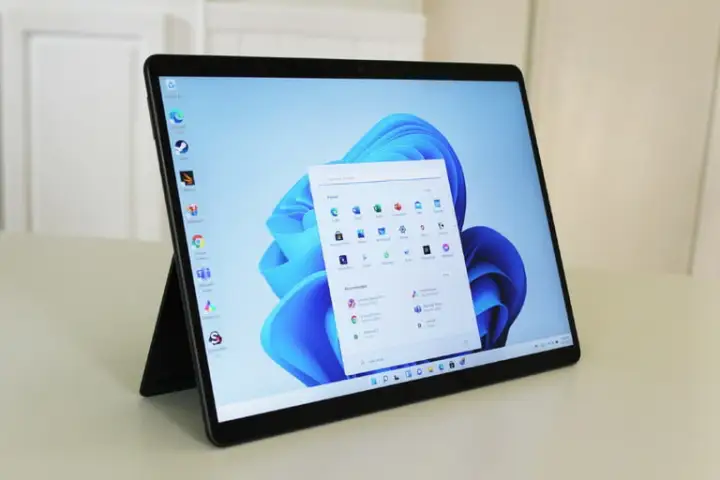
The Surface Pro 8 comes with a single display option, a very sharp 13-inch 3:2 IPS 2880 x 1920 panel running at 120Hz. That makes Windows 11’s interface and animations smooth as silk and an improvement over the pedestrian 60Hz displays in the Yoga. As mentioned previously, the display also supports the haptic feedback in the Surface Slim 2 Pen, which is another advantage. The Yoga 9i 14 Gen 7 has three 14-inch 16:10 display options, a Full HD+ (1920 x 1200) IPS panel, a WQHD+ (2880 x 1800) OLED panel, and a WQUXGA (3840 x 2400) OLED screen.
We tested the Yoga’s WQHD+ OLED option and found it to provide a subjectively and objectively spectacular experience. Colors were dynamic and accurate, the screen was extremely bright, and the usual OLED inky blacks were on display. The Surface Pro 8’s display was equally bright, but its colors weren’t nearly as wide nor as accurate, and its contrast couldn’t compare.
You won’t hate the Surface Pro 8’s display for productivity work. But creative types will love the OLED options on the Yoga 9i 14 Gen 7.
| Lenovo Yoga 9i 14 Gen 7 | Microsoft Surface Pro 8 | |
| Brightness (nits) |
406 | 406 |
| AdobeRGB gamut | 95 | 79 |
| sRGB gamut | 100 | 99 |
| Accuracy (DeltaE, lower is better) |
0.87 | 1.4 |
| Contrast ratio | 28,380:1 | 1,010:1 |
Portability

The Surface Pro 8 is smaller in all dimensions when you consider the tablet alone, and it’s also less than half the weight of the Yoga 9i 14 Gen 7. Add on the Signature Type Cover and it’s a bit thicker and heavier, but it’s still easier to carry around and use as a pure tablet than the Yoga. That’s not to say Lenovo’s 2-in-1 isn’t a viable thin-and-light laptop; it’s just not as portable as the Surface Pro 8.
In terms of battery life, things were closer than we expected. The Yoga 9i 14 Gen 7 enjoys a large 75 watt-hour battery to go with its power-hungry 14-inch OLED display and its faster CPU (which we hoped would be more efficient given Intel’s efficiency claims around its 12th-gen processors). That compares to the Surface Pro 8’s skimpier 51.5 watt-hour battery. However, our web browsing and video battery tests weren’t that far apart, with the Yoga taking a slight lead that doesn’t promise much more in the way of real-life longevity.
Both laptops will likely get you through a full day’s work if you don’t tax the CPU. You might get a little more life out of the Yoga, but again, not as much as we expected given the significantly larger battery.
| Lenovo Yoga 9i 14 Gen 7 (Core i7-1260P) |
Microsoft Surface Pro 8 (Core i7-1185G7) |
|
| Web browsing | 9 hours 10 minutes | 8 hours 31 minutes |
| Video | 12 hours 45 minutes | 10 hours 48 minutes |
The Yoga 9i 14 Gen 7 is a great convertible 2-in-1, but the Surface Pro 8 is the best tablet
There are currently only two configurations available for the Yoga 9i 14 Gen 7. The low end is a $1,450 model with a Core i7-1260P, 8GB of DDR5 RAM, a 256GB PCIe 4.0 SSD, and a 14-inch Full HD+ display. Our $1,730 review unit was equipped with the Core i7-1260P, 16GB of DDR5 RAM, a 512GB PCIe 4.0 SSD, and the WQHD+ (2880 x 1800) OLED panel.
The Surface Pro 8 starts at a more reasonable $1,100 for a Core i5, 8GB of DDR4 RAM, and a 128GB PCIe 3.0 SSD. You’ll spend $2,600 for a Core i7, 32GB of DDR4
These are both excellent laptops that excel at what they aim to do. The Surface Pro 8 wants to be an exceptional tablet that can work as a functional clamshell, and it succeeds. The Yoga 9i 14 Gen 7 wants to be a clamshell first that offers additional flexibility, including occasional use as a tablet, and it succeeds as well. Overall, the Surface Pro 8 stands out given its nearly perfect tablet design. It’s not as fast as the Yoga, but it’s ultimately the better example of its 2-in-1 form factor.


